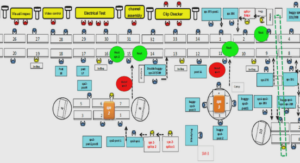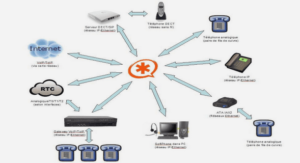In today’s industrial robotic cells, efficiency is a key factor to mass production. Faster process cycle time leads to more production and more business value. Industrial robots are mainly used in repetitive applications, therefore, they successfully perform tasks programmed in teach mode and through off-line programming. Some examples of typical robot applications are pick and place operations, welding, painting, gluing, assembly, inspection, machining, drilling or composite fiber placement. One aspect that can be improved in order to minimize cycle time and thus increase productivity, is task placement. The goal of task placement optimization is to find the best layout of the workcell that minimizes the production time while avoiding singularities and obstacles .
In the simplest case, a layout consists of one robot and one path (task). In such a layout placement of the path with respect to the robot is to be optimized. Consider, for example, a laser cutting robot that needs to cut a metal plate that is held by a jig. Although we talk about path placement, in practical terms, we need to find the optimal placement of the jig. Such robotic cells can be more complex; for example multi robot collaboration with the presence of external axes, presence of obstacles in the environment, discretization of the operations, etc. These challenges add to the level of complexity and therefore need advanced optimization techniques.
Optimal motion planning has been a relevant area for robotics researchers for many years. Several authors have worked on motion planning based on different optimization objectives (Ur-Rehman et al. (2010)). A review of trajectory planning techniques is given in (Ata (2007)). Various optimization objectives can be considered, such as energy consumption (Field & Stepanenko (1996); Hirakawa & Kawamura (1997)), travel or machining cycle time (Chan & Zalzala (1993); Pateloup et al. (2004)), minimum traveled distance (Tian & Collins (2003)), while satisfying several geometric, kinematic and dynamic constraints.
The trajectory planning deals with the determination of the path and velocity/acceleration profiles (or the time history of the robot’s joints), the start and end points of the trajectory being predefined and fixed in the workspace. Another less explored aspect of trajectory planning is the placement of a given path within the workspace. It aims at determining the optimum location of a predefined path to be followed by the EE of a PMs or a robot, within its workspace with respect to one or many given objective(s) and constraint(s). This path can be the shape of a component to be machined, a welded profile or an artistic/decorative profile etc. In such situations, the trajectory planner cannot alter the shape of the path but he/she can only play with the location of that path within the workspace in order to optimize one or several criterion(a). Such an approach can be very interesting in many robotic applications. For example, in machining applications, the location of the workpiece within the workspace may affect the electric energy used by its actuators.
The path placement problem has not been extensively studied in the past. Nevertheless, some researchers proposed to solve it with respect to various optimization objectives. Several performance criteria for path location problems can be considered simultaneously (multi-objective) or individually, such as travel time, different kinetostatic performance indices (such as, ma-nipulability or the conditioning number of the normalized kinematic Jacobian matrix), kinematic performance (velocity, acceleration), collisions, wear and vibration reduction, energy consumption etc.
Empirical performance criteria based on geometric and physical properties are commonly used for real-time decision-making (and design) of redundant anthropomorphic workcells performing high level tasks while avoiding obstacles, providing safety, and responding to human commands. Tisius et al. (2009) described 50 operational criteria and 50 potential criteria for serial manipulator operation. Machining or fiber placement quality, as well as robot energy consumption may also depend on the workpiece placement.
Optimal location of a task and optimal trajectory planning are an important research fields of robotics. In most cases, the presented works in the relevant literature introduce an index that allows the quantification of some aspect(s) of the manipulator’s performance during task execution, a method, the mathematical formulation of the optimal task placement problem according to the considered constraints and the introduced index and a search method (Valsamos et al. (2018)). In most of these works, the results for the considered test cases that are examined to validate each of the proposed methods are mainly (with a very few exceptions such as (Ur-Rehman et al. (2010), Erdos˝ et al. (2016)) in this case) numerical and simulation based.
Workpiece (path) placement
Workpiece placement is always subject to redundancy, even in the presence of just one manipulator. The Degree Of Redundancy (DOR) in the workpiece placement is independent of the robot DOF and can be higher. (Caro et al. (2013)) determines the optimum placement of the workpiece to be machined, considering the elastostatic model of the robot and the cutting forces applied on the tool. In (Robin et al. (2011)), a redundancy resolution for polishing operations is suggested. The kinematics capability is chosen to be the speed ratio of the End-Effector (EE), since they wanted to obtain voluntarily non-isotropic behavior. In (Ur-Rehman et al. (2010)), multi objective path placement optimization for Parallel Mechanism (PM)s uses GA in order to minimize actuator torques, energy consumption, and shaking forces, for a 3 DOF PM. It is argued in (Vosniakos & Matsas (2010)) that it is more efficient to perform the milling operation in regions of the robot’s workspace where manipulability is highest. Therefore the best initial pose of the robot is obtained to maximize manipulability. In (Hemmerle & Prinz (1991)), the authors numerically solved the problem of path placement for redundant manipulators. This included the problem of where to place the components (tables, other robots, or machining stations) relative to each other, as well as how to resolve the redundancies of the workcell. None of the aforementioned studies considers the path placement for a coordinated redundant robotic workcell that has a second manipulator detached from the main manipulator. They all place the path on a fixed platform rather than a moving platform. Furthermore, they neglect to perform the trajectory optimization simultaneously for both the main manipulator and the redundant manipulator.
In a more recent article, (Gao et al. (2017c,b,a)), the authors propose an approach to optimize the path planning of a robot and positioner in a redundant workcell for a fiber placement task. Time-optimal profiles for the joint variables are obtained by discretization of the problem, wherein all possible motions of the robot and positioner are represented as directed multi-layer graphs. This technique is based on the discrete dynamic programming principle, which allows finding the global optimum by sequentially solving all possible sets of the problems of lower dimensions. However, since the workspace of the positioner is discretized, for each motion of the positioner, the time-optimal solution is obtained by reducing to analysis of the preceding node at each step. Furthermore, the method does not take the placement of the positioner and the path on the positioner into account. The goal of (Gao et al. (2017c,b,a)) is one part of the objective of this chapter. This part will be referred to as the 1D optimization, i.e. optimization of the rotary table’s motion.
The same objective of fiber placement redundancy resolution is investigated in (Hely et al. (2017); Hely (2016)). They obtain the optimal trajectory for rotary table by the means of gradient projection method. This method is a powerful tool when it comes to 1 DOF redundancy resolution, but for higher DOF workcells, it can only result into local optimums.
The optimal positioning of tasks in robot applications is an extremely important step in the design of robotic cells as it will allow the system to achieve the required high performance given the selected performance measure. In (Valsamos et al. (2018)) the optimal positioning of a robotic task is presented with the aim to minimize the required joint velocities during task execution, for a 6 DOF manipulator. The method is used to determine the optimal location for a path following task in the workspace of a UR5 manipulator. Results show that the optimal task placement allows for a significant reduction of joint velocities to maintain a given constant EE velocity during task execution.
Mlynek et al. (2018) discuss the quality of the manufacturing process technology of a shaped composite in 3D space. The mathematical model of the winding process and the matrix calculus are used to determine the optimized 3D trajectory of EE. The differential evolution algorithm is applied to finding the optimized 3D trajectory of the EE.
INTRODUCTION |





